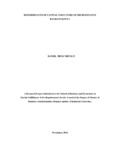| dc.description.abstract | Most capital structure studies to date are based on data from developed countries’ firms and very few studies provide evidence from developing countries. Capital structure of Microfinance banks in Kenya has not been investigated; there is no clear understanding on how microfinance banks construct their capital structure and what internal (firm-specific) factors influence their corporate financing decision. This study attempted to fill this gap by analyzing the capital structure for microfinance banks in Kenya. Guiding study objectives were; to determine influence of Profitability, Tangibility, firm Size, Age, Business risks, Capital Adequacy and Tax-Shield) on capital structure of Microfinance banks. The study was guided by static trade off theory, agency theory, pecking order theory and bankruptcy theory. A sample of three major microfinance banks was selected and secondary data were collected. Consequently, multivariate regression analysis was made based on financial statement data of the selected microfinance banks over the five year period. The findings of the study indicated that (size, age and profitability, business risks and capital adequacy) variables are the significant firm level determinants of capital structure in Kenyan microfinance banks (p<0.001, p<0.001, p<0.001 and p<0.001) respectively. In addition, (size, age and profitability) variables showed a positive relationship with capital structure (β =0.216, β =0.015, β =0.667) while the remaining four variables (asset tangibility, tax-shield, business risks and capital adequacy) showed a negative relationship with capital structure (β= -0.166, β= -0.317, β= -0.158 and β= -0.007) respectively. According to the research findings, there is consistency between Size and Static Trade off Theory, Age and Static Trade off Theory, Profitability and Static Trade off Theory, Tax shield and Static Trade off Theory Business risks and Agency Cost theory and Bankruptcy Cost Theory in Kenyan microfinance banks. It was recommended that microfinance banks should try to maintain an optimum mix financing between short-term and long term debt capital since the findings revealed that microfinance banks in Kenya tends to use short term debt capital to finance their operations as opposed to long term debt capital. Microfinance banks were found to rely on debt financing than equity financing. They should diversify in their capital financing strategy by considering equity financing also through selling stocks to members of the public or through private placement to institutional investors so as to maintain an optimum capital structure. The findings show that shows that microfinance banks in Kenya are not benefiting from tax advantage of interest expenses, thus finance managers should focus their on tax-shield variable. | en_US |
| dc.subject | Microfinance banks, Leverage ratio, Capital structure, Size, Age, profitability, Asset Tangibility, Tax charge, Business risks, Capital adequacy | en_US |

